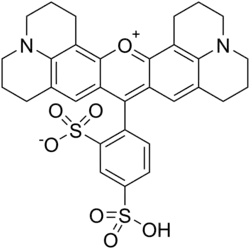Sulforhodamine 101
 | |
| Identifiers | |
|---|---|
3D model (JSmol)
|
|
| 3582548 | |
| ChemSpider | |
| ECHA InfoCard | 100.056.491 |
| EC Number |
|
PubChem CID
|
|
| UNII | |
CompTox Dashboard (EPA)
|
|
| |
| |
| Properties | |
| C31H30N2O7S2 | |
| Molar mass | 606.71 g·mol−1 |
| Hazards | |
| GHS labelling:[1] | |

| |
| Warning | |
| H315, H319, H335, H412 | |
| P261, P264, P264+P265, P271, P273, P280, P302+P352, P304+P340, P305+P351+P338, P319, P321, P332+P317, P337+P317, P362+P364, P403+P233, P405, P501 | |
Except where otherwise noted, data are given for materials in their standard state (at 25 °C [77 °F], 100 kPa).
Infobox references
| |
Sulforhodamine 101 (SR101) is a red fluorescent dye. In neurophysiological experiments which comprise calcium imaging methods, it can be used for a counterstaining of astrocytes to be able to analyze data from neurons separately.[1] However, in addition to labeling astrocytes, SR101 labels myelinating oligodendrocytes.[2] SR101 has been reported to affect excitability of neurons and should therefore be used with caution.[3]
A sulfonyl chloride derivative of sulforhodamine 101, known as Texas Red, is used for conjugation to a number of functional groups, especially primary amines.
References
- ^ Nimmerjahn, A.; Kirchhoff, F.; Kerr, J.N.; Helmchen, F. (2004). "Sulforhodamine 101 as a specific marker of astroglia in the neocortex in vivo". Nature Methods. 1 (1): 31–7. doi:10.1038/nmeth706. PMID 15782150. S2CID 2073853.

- ^ Hill, R.A.; Grutzendler, J. (2014). "In vivo imaging of oligodendrocytes with sulforhodamine 101". Nature Methods. 11 (11): 1081–1082. doi:10.1038/nmeth.3140. PMC 4539948. PMID 25357236.

- ^ Kang, J.; Kang N.; Yu, Y.; Zhang, J.; et al. (2010). "Sulforhodamine 101 induces long-term potentiation of intrinsic excitability and synaptic efficacy in hippocampal CA1 pyramidal neurons". Neuroscience. 169 (4): 1601–1609. doi:10.1016/j.neuroscience.2010.06.020. PMC 2918738. PMID 20600669.